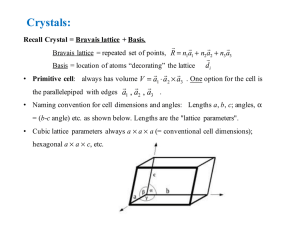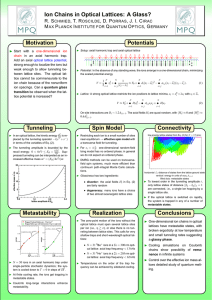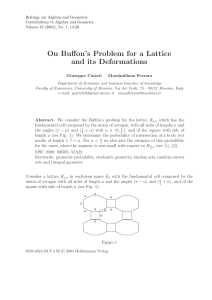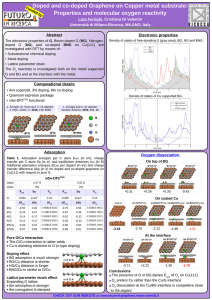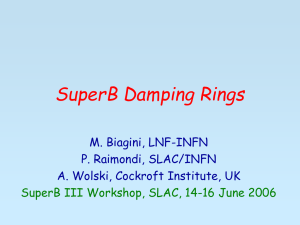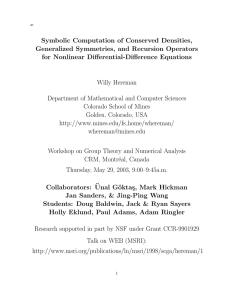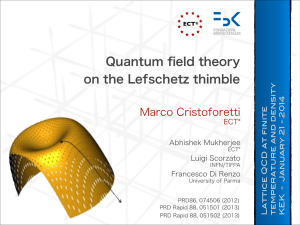Document 11584372
advertisement
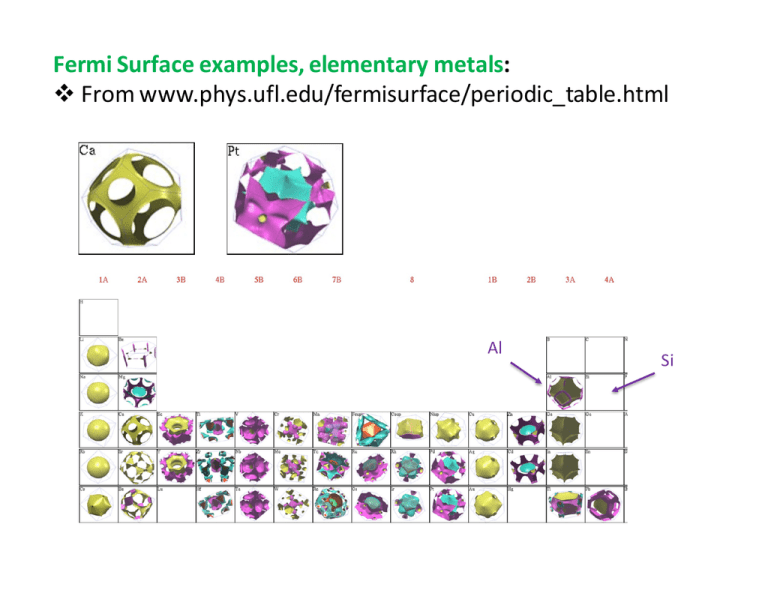
Fermi Surface examples, elementary metals: v From www.phys.ufl.edu/fermisurface/periodic_table.html Al Si La1-­‐xSrxCuO4 superconductor (ARPES measurement) Razzoli et al. New J. Physics 2010 ARPES: Angle-­‐resolved photoemission spectroscopy; Fermi surface & electron energy measurement technique (synchrotron source) Recall: kF = 3 3π 2 n ε = 2 k 2 2m 2⎛m⎞ g (ε ) = 2 ⎜ 2 ⎟ π ⎝! ⎠ 3/ 2 ε Free electron result ⎛π 2 ⎞ 1 c ≅ k BTg (ε F )⎜⎜ ⎟⎟ ≡ γT V ⎝ 3 ⎠ Same as (free electrons) c≅ Sommerfeld π 2 nk B ⎛ T 2 ⎞ ⎜ T ⎟ ⎝ F⎠ Real metals with periodic potentials: • Derived relationships containing g(ε) unchanged. • However g(ε) will differ due to crystal-potential Transport properties in metals: Electrical conductivity: Classic relationship (Drude): ne τ j = −ne v = + m 2 ne τ σ= m 2 • Electron wave-packets: in field, can show, & see text ch. 13 “semiclassical model” ! dk − e ! ≈ E dt " • Scattering; only allowed for electrons near Fermi surface. • But as k changes, τ = collision time can define for all electrons, dn n = − ⇒ τ = lifetime dt τ Fermi surface displaced. • So classical formula may apply to Fermi gas situation; scattering due to defects or phonons. Not from regular crystal positions Transport properties in metals: Electrical conductivity: Classic relationship (Drude): ne τ j = −ne v = + m 2 k F = 3 3π 2 n ne τ σ= m 2 ε F = ! 2 k F 2 2m = ! 2 (3π 2 n) 2 / 3 2m 2⎛m⎞ g (ε F ) = 2 ⎜ 2 ⎟ π ⎝! ⎠ 3/ 2 ( m 3π 2 n εF = ! 2π 2 ne 2τ 2 e 2τ g (ε F )vF2 e 2τ σ= = g (ε F )ε F = m 3 m 3 ) 1/ 3 (Expressed in terms of Fermi surface properties only) • Classical formula often applied to Fermi gas situation; scattering due to defects or phonons. or other electrons, etc. Transport properties: Matthiessen’s rule: Scattering rates add. 1 τ = 1 τ impurity + 1 τ phonons + ... • General rule; uncorrelated processes, metal resistivities add. • Impurities always decrease mobility (increase resistivity) • Alloy resistivity may be large & constant vs. T. eτ µ= m σ = neµ ≡ 1 / ρ mobility ρ = ρ impurity + ρ phonons + ... With impurities 1 τ ∝ n phonon High T, Good metal Transport properties: Mobilities: eτ µ= m Measures scattering rate • Mass also modified for states in crystal potential, [example, graphene m* = 0] µ ~ 100 cm V .s RT 2 • GaAs, µ ~ 1000 cm V .s µ ~ 107 cm 2 V .s • “world record” • Copper, 2 Metal, n is constant, conductivity decrease vs. T. Semiconductor n and σ increase as T increases. Transport properties: Mobilities: eτ µ= m Measures scattering rate τ ~ 10 −13 s, ! ~ 10 −5 cm µ ~ 100 cm V .s RT 2 • GaAs, µ ~ 1000 cm V .s µ ~ 107 cm 2 V .s • “world record” • Copper, 2 quantum hall effect – systems; electrons “ballistic” “high electron mobility transitor” Transport properties: 1 Thermal conductivity, κ el = C!v 3 • Works for degenerate system too • v (mean speed) is Fermi velocity for good metals. • Specific heat we have seen: C = γT • Generally electron + phonon contributions to κ add. κ el 2 κ el π ⎛ k B ⎞ = ⎜ ⎟T σ 3 ⎝ e ⎠ 2 Wiedemann-Franz law (see ch. 1, different result for classical case) ⎛π 2 ⎞ 1 c ≅ k BTg (ε F )⎜⎜ ⎟⎟ ≡ γT V ⎝ 3 ⎠ g (ε F )vF2 e 2τ σ= 3 Crystals: Reading: Ch. 3, Ch. 4, Ch. 7. Crystal = Bravais lattice + Basis. R = n a + n a + n a Bravais lattice = repeated set of points, 1 1 2 2 3 3 ! di Basis = location of atoms “decorating” the lattice • Primitive Lattice vectors: a1 , a2 , a3 (not unique) • Primitive cell. Space region, translated by all lattice vectors will fill space. (not unique) • Wigner Seitz primitive cell: space region closer to a given Lattice Point than any other Lattice Point. Has the same point group symmetry as the lattice. • Conventional cell: Larger than primitive cell, still tiles space, normally chosen to show crystal symmetry. (Example: silicon conventional cell = cube; primitive cell is that of the face-centered cubic [FCC] lattice, 4 times smaller.) Symmetry classes 14 Bravais lattices All Hexagonal with Space group 194 Including symmetry of point group (lattice decoration), 230 “Space Group” Symmetry classes

